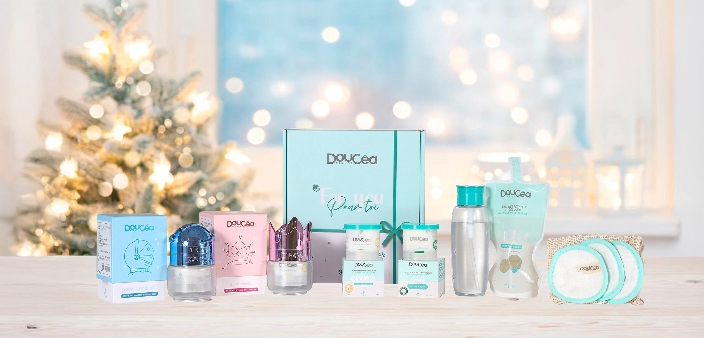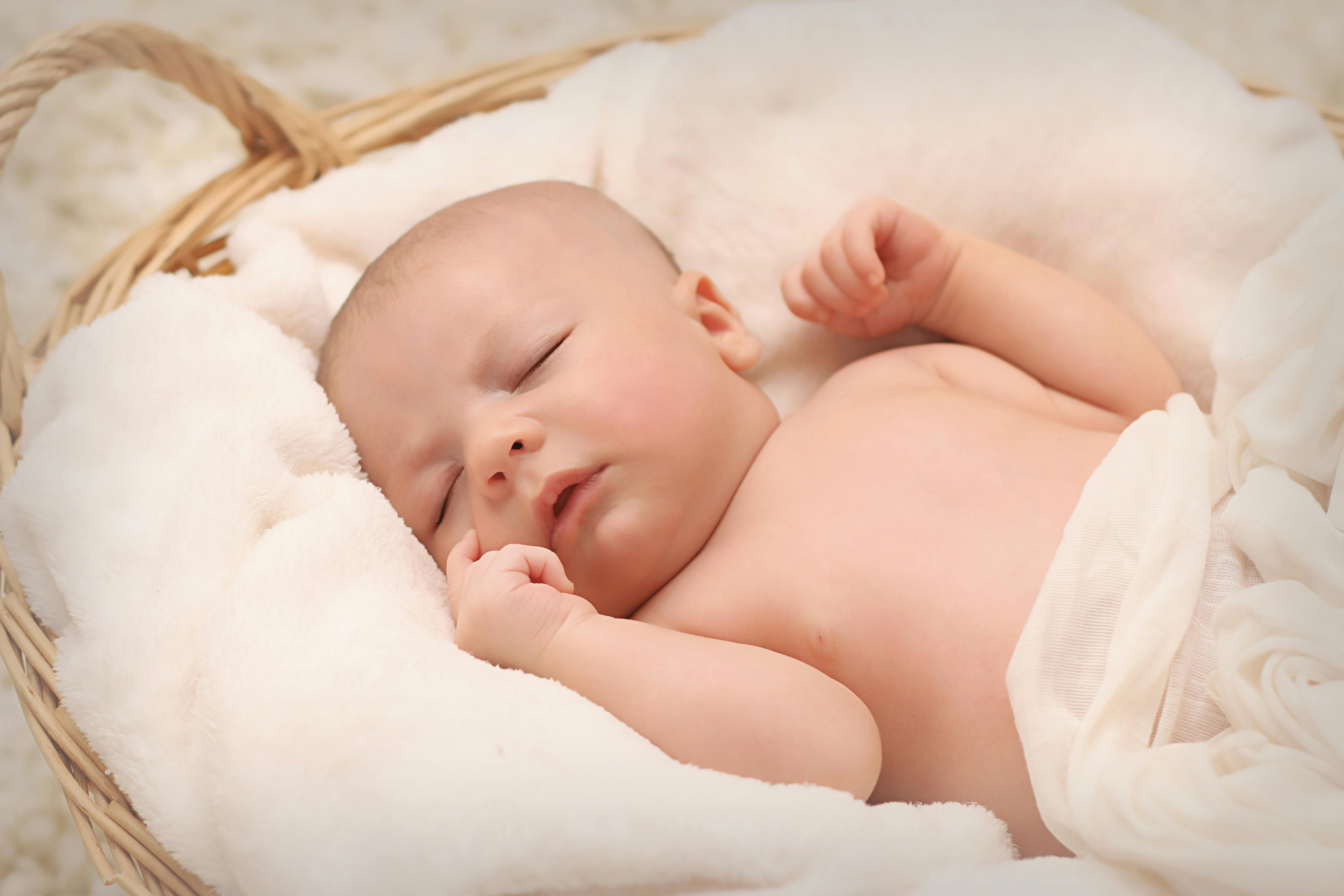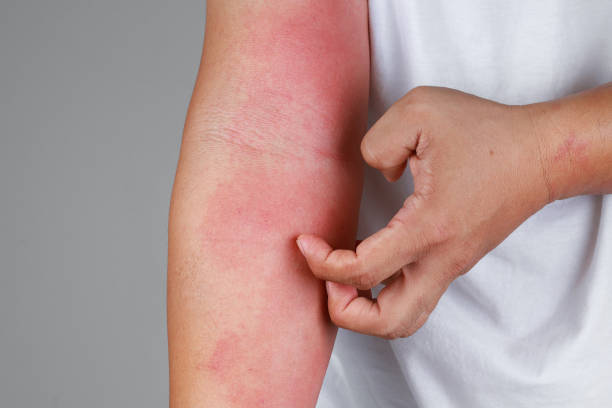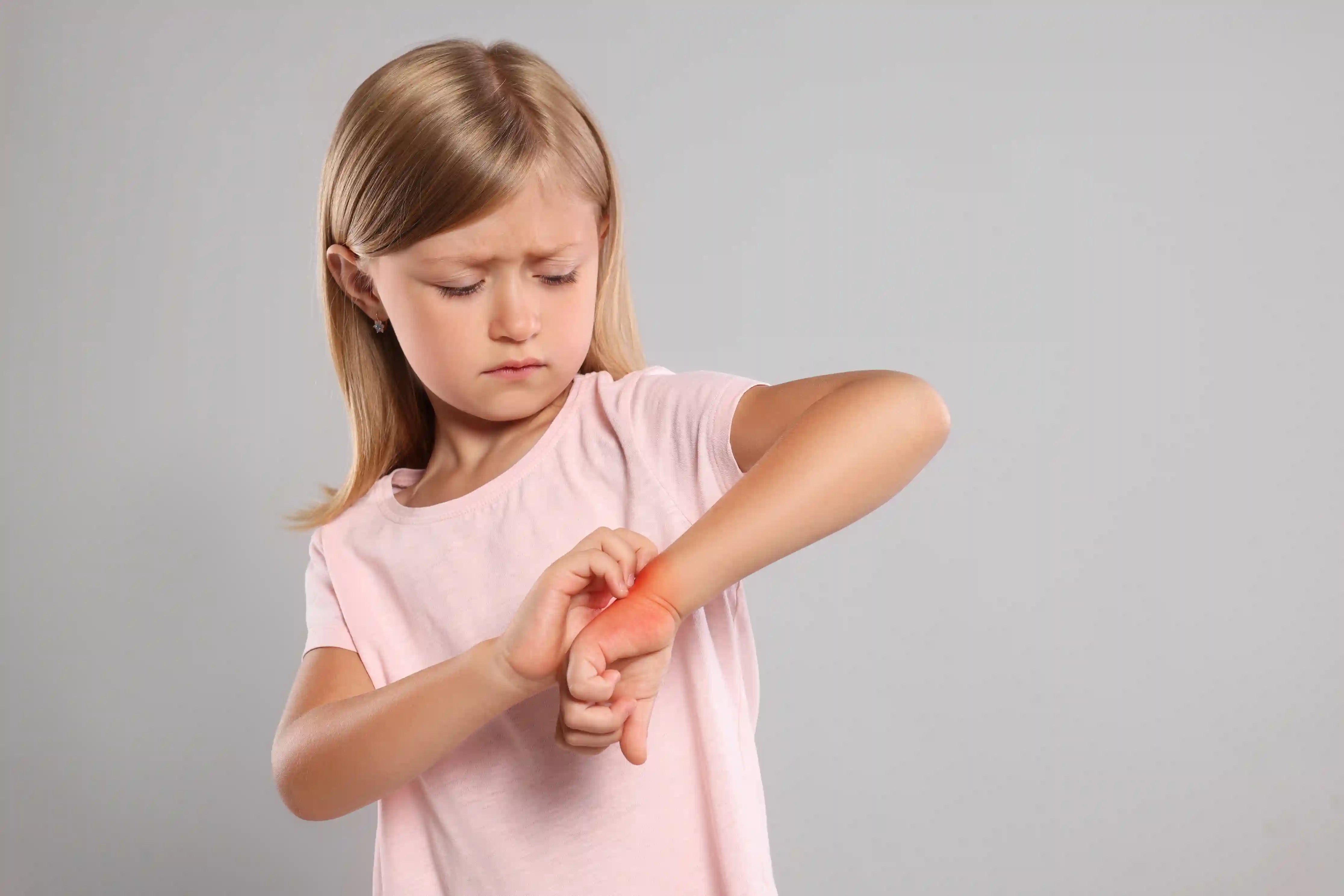Cradle cap, also known as infant seborrheic dermatitis, is characterized by small yellowish or whitish patches that appear on a baby’s scalp. It is sometimes compared to dandruff because of the greasy flakes visible in the baby’s hair.
Although its appearance might worry new parents, rest assured: cradle cap is very common and harmless (it affects around two-thirds of babies during their first few months). It doesn’t cause pain or discomfort to the infant and typically goes away on its own over time.
This article provides a complete guide to cradle cap: it explains the condition in detail, its causes, the areas of the body most commonly affected, and the lack of correlation with the baby’s hygiene or diet.
We also cover what not to do, the recommended treatments and gentle care steps to remove cradle cap safely, as well as natural remedies and soft daily routines to soothe your baby’s sensitive skin.
Finally, we’ll introduce how Doucéa’s products, with their skin-friendly composition specially formulated for babies, can help treat or prevent cradle cap effectively and gently.
Our goal is to inform you with professionalism and kindness, so you can take care of your baby’s scalp with complete peace of mind.
Causes and Contributing Factors of Cradle Cap
Cradle cap is associated with several physiological factors specific to infants. The main cause is an overproduction of sebum on the scalp. In newborns, the sebaceous glands (which produce sebum, a protective oily substance) can be stimulated by maternal hormones still present in their bodies after birth.
During late pregnancy, certain maternal hormones pass into the baby's bloodstream. After birth, they continue to act temporarily and can overstimulate the baby’s sebaceous glands. This excess sebum prevents dead skin cells from shedding properly: they accumulate and stick together, forming thick patches of dead skin "clumped" by sebum. This is how cradle cap forms.
Another common factor is the presence of a natural yeast on the skin called Malassezia (a microscopic fungus). This yeast thrives in sebum-rich areas like the scalp. When sebum levels are high, it can multiply excessively and contribute to local inflammation. In short, excess sebum promotes the proliferation of this natural microbe, which irritates the skin and accelerates cell turnover, generating a large number of flakes. That’s why cradle cap is considered a combination of oily skin and yeast overgrowth leading to the characteristic patches.
Other factors may also make some babies more prone to cradle cap. Genetics may play a role: if the parents have oily skin or a history of seborrheic dermatitis, the child may be more likely to develop it. It has also been observed that babies with severe cradle cap sometimes have oilier skin later in life, although this remains anecdotal and not scientifically confirmed.
Additionally, using unsuitable skincare products can worsen the condition. For instance, using harsh soaps or shampoos not formulated for babies can irritate the delicate scalp and trigger a reflex overproduction of sebum. This creates a vicious cycle where irritated skin produces more oil, which worsens the crusts.
Lastly, heat and excessive sweating can also contribute to cradle cap. A baby who sweats heavily from the head—especially if overdressed—will have a constantly damp scalp, which encourages yeast growth and flake formation.
Thus, a variety of elements—including hormones, sebum, microbes, and improper care—converge to explain why some babies develop cradle cap more than others.
It's important to note that, unlike other infant skin conditions (like atopic eczema), cradle cap is not caused by allergies or dietary issues. We'll explore this topic further in the next section, discussing the often misunderstood link between cradle cap, hygiene, and diet.
What Areas of the Body Are Affected?
Cradle cap primarily appears on the head, especially on the baby’s scalp. It is most commonly seen at the top of the head, around the anterior fontanelle (the soft spot between the bones of a newborn’s skull). It may begin in one small area and gradually spread to cover a larger portion of the scalp, sometimes forming a helmet-like layer of flakes.
In most cases, cradle cap is limited to the scalp. However, it’s not unusual for it to extend slightly beyond this area: small flakes or yellowish crusts can appear on the eyebrows, near the eyelashes, or behind the baby’s ears. All these areas are part of the same infant seborrheic dermatitis condition.
In rarer cases, cradle cap may spread to other parts of the body. This is referred to as extended seborrheic dermatitis. The affected regions are typically areas rich in sebaceous glands or where skin folds occur: the neck folds, armpits, behind the knees or elbows, the groin, and even the diaper area.
These red patches in the skin folds may be accompanied by flaking and are part of the same process (they differ from classic diaper rash in that the texture is greasier and more scaly). If the lesions become very widespread on the body, it may indicate atopic eczema in a baby with allergic tendencies (sometimes referred to as "wet" cradle cap). In such cases, it's best to consult a pediatrician or dermatologist, as atopic eczema requires specific care.
Nevertheless, for the vast majority of babies, cradle cap remains localized on the head and possibly the eyebrows, without spreading elsewhere on the body.
In summary, focus your attention on your baby's scalp: this is where cradle cap typically begins. Also check the eyebrows and behind the ears, where flakes can accumulate. If you notice similar lesions elsewhere (in skin folds or on the buttocks), consult a healthcare provider to rule out other potential causes.
What About Hygiene and Diet—Are They to Blame?
When crusty patches appear on a baby’s head, many parents understandably wonder: is this a hygiene issue? Did I do something wrong? The term “cradle cap” might even lead some to assume it has something to do with milk. Let’s clear up these common misconceptions to avoid unnecessary guilt.
➜ Poor Hygiene?
No, cradle cap is not caused by poor hygiene. It's not a result of washing your baby’s hair too little. As explained earlier, internal factors—such as hormones, sebum production, and natural yeast—are responsible. In fact, infant seborrheic dermatitis is unrelated to dirt or cleanliness.
Some parents worry about not cleaning their baby's scalp “well enough,” but the presence of cradle cap does not mean the baby is dirty. Of course, gentle scalp care is encouraged (we’ll cover proper care methods later), but rest assured: cradle cap is not your fault.
On the contrary, overwashing or using harsh shampoos can irritate the delicate skin of a newborn and worsen the condition. So, the key is balance. Just remember: cradle cap does not mean poor hygiene or neglect.
➜ Infant Diet and Milk?
Again, there’s no direct link between a baby’s diet and cradle cap. The name is misleading—it has nothing to do with the milk your baby drinks or breast milk. The term only refers to the crust’s appearance, which resembles dried milk.
Cradle cap occurs in both breastfed and formula-fed babies and isn’t related to milk intolerance or nutritional deficiencies. Unlike certain forms of allergic eczema, infant seborrheic dermatitis is not a reaction to food allergens.
So, there’s no need to alter your baby’s diet or the diet of a breastfeeding mother in hopes of eliminating cradle cap. In extremely rare cases where the crusts are weepy and widespread (sometimes called "wet" cradle cap), they may actually be part of atopic eczema—this would require evaluation by a doctor.
But for healthy infants with typical cradle cap, no special diet is needed.
In summary: Neither poor hygiene nor your baby’s diet causes cradle cap. There’s no need to over-wash your baby’s scalp or change their formula or your breastfeeding diet. Instead, focus on gentle care techniques—which we’ll outline in the following sections. Most importantly, don’t blame yourself. Cradle cap is a common, harmless condition even among the healthiest babies. What matters most is knowing how to manage it properly.
What Not to Do When Treating Cradle Cap
Before diving into recommended treatments, it’s crucial to understand what not to do when dealing with cradle cap. Well-meaning actions can sometimes worsen the condition or hurt your baby’s delicate skin. Here are key mistakes to avoid:
➤ Don’t Scratch or Pick at the Crusts
This is the most important rule. Never try to remove cradle cap by scratching it off with your nails or using a comb! Although it might be tempting to lift the patches, forcibly removing them can do more harm than good.
A baby’s skin is very thin and sensitive. Scratching can cause injury, bleeding, or even infection. Additionally, forcibly removed crusts tend to return—sometimes thicker. Let them loosen naturally with appropriate care, which we’ll explain in the next section.
➤ Don’t Use Hard Brushes or Fine-Tooth Combs
Avoid any abrasive tools on your baby’s scalp. Fine-tooth combs, stiff brushes, or vigorous rubbing can irritate the skin without effectively removing the flakes.
Always use a super-soft baby brush and apply it gently.
➤ Don’t Apply Harsh or Inappropriate Products
Never use adult hair treatments (like anti-dandruff shampoos) on a baby’s scalp—they are far too harsh. Avoid alcohol-based lotions, exfoliants, or concentrated essential oils: these can cause significant irritation.
A baby’s skin has a different pH and a developing skin barrier. It requires gentle, baby-formulated products. As a rule of thumb: if it’s not made for babies, don’t use it.
➤ Don’t Experiment with Home Remedies Without Medical Advice
You might hear about unconventional solutions like onion or lemon juice. Be cautious—many of these unverified tips can irritate delicate skin. For example, antifungal essential oils like tea tree are not recommended for infants, as they can trigger allergic reactions.
Stick to gentle, proven methods (detailed in the next section), and always ask your pediatrician before trying something new on your baby’s skin.
➤ Don’t Panic
This isn’t a strict “don’t,” but an important reminder: try to stay calm. Seeing crusty patches on your baby’s head can be stressful, but remember that cradle cap is harmless.
Don’t overdo the care routine—repeated washing or multiple treatments a day may worsen irritation. Instead, maintain a simple, consistent routine once or twice a day and be patient.
By avoiding these common mistakes, you’re already helping your baby’s skin heal properly. Let’s now explore the gentle and effective steps you can take to safely treat cradle cap.
How to Treat and Remove Cradle Cap (Recommended Steps)
Treating cradle cap involves gentle daily care to help loosen and remove the crusts without irritating the skin. In most cases, these simple actions are enough to make cradle cap disappear. Here’s what pediatricians and dermatologists recommend:
1. Soften the Crusts with an Oily Substance
The secret to removing cradle cap without force is softening the patches beforehand. Use a greasy substance like petroleum jelly (commonly used in pediatrics) or a food-grade plant oil such as olive or sweet almond oil (preferably organic).
Apply a thick layer of oil or jelly on the affected areas to soak the crusts. Do this about 2 hours before your baby’s bath. Gently massage the scalp with your fingers to help the oil penetrate.
Tip: If the crusts are very thick, apply the oil in the evening, put a light cap on your baby, and let it sit overnight. The next morning, the crusts will be easier to remove.
2. Wash Baby’s Hair with a Gentle Shampoo
During bath time, use a gentle baby shampoo—soap-free and pH-neutral—ideally one formulated for cradle cap. Wet your baby’s head with warm water, apply the shampoo, and lather gently.
The shampoo helps remove excess oil and loosen scales. Rinse thoroughly with clear water. Continue massaging the scalp gently during the wash to lift the softened crusts.
3. Remove the Crusts with a Soft Brush
After shampooing, with damp or slightly dried hair, use a baby brush with ultra-soft bristles. Brush gently in circular motions: the crusts should come off easily if properly softened.
Don’t force resistant patches—they will fall off naturally over the next few days. It’s normal if some hair comes off—they will grow back. The goal is a slow, gentle process.
4. Repeat Regularly
Consistency is key. Repeat these steps daily or every other day, depending on the severity of the cradle cap. A daily bath is often recommended during this time.
Once the cradle cap resolves, you can return to bathing two to three times a week. Don’t forget to clean the brush after each use with hot soapy water to prevent contamination.
Progress and Treatment Duration
Following these steps, cradle cap usually improves within days and disappears within two weeks in most cases.
What Not to Do
Never scratch to speed up the process. If a patch remains, repeat the process the next day. Over time, they will naturally fall off.
When to See a Doctor
Cradle cap usually doesn’t require medication, but you should consult a pediatrician if:
- The crusts persist after 2 weeks despite care.
- They spread or worsen on the body.
- You notice signs of infection: bright redness, oozing, cracks, or bleeding.
- Your baby has a fever or seems bothered (fussy, scratching the head).
- The crusts appear on other parts of the body (diaper area, folds), possibly indicating atopic eczema.
If needed, a doctor may prescribe a topical treatment (antifungal, antibiotic, or mild corticosteroid). But in most cases, gentle care is sufficient.
Natural Solutions and Gentle Remedies
Many parents seek natural remedies to address cradle cap, wanting only gentle, baby-safe products. The good news is that the care described above already relies on simple, natural principles—oils, gentle brushing, etc. Here are some additional tried-and-true home remedies and natural options to support your routine:
➤ Vegetable Oils (Sweet Almond, Olive…)
This is the #1 natural remedy. Applying food-grade oil to your baby's scalp effectively softens the crusts. Sweet almond oil is especially popular for its gentleness and tolerance—it nourishes the skin and helps lift the flakes. Virgin olive oil, commonly found in kitchens, works just as well if left on long enough.
Some parents also use coconut oil, known for its natural antifungal properties. If you try it, ensure it’s food-grade and fragrance-free.
Warm the oil slightly in your hands, apply to baby’s scalp, and let it sit for 1–2 hours—or overnight for stubborn crusts. Tip: place a soft cotton cap on baby’s head during the wait to avoid staining sheets or clothes.
➤ Petroleum Jelly (Vaseline)
Though not "natural" in the ecological sense, petroleum jelly is a classic and safe option. It’s transparent, odorless, and hypoallergenic, making it a neutral greasy base to soften cradle cap just as effectively as oils. Pediatricians often recommend pharmaceutical-grade unscented Vaseline.
➤ Oleo-Calcareous Liniment
This traditional mixture of limewater and olive oil is well-known for cleansing and protecting baby skin. Less known: it can also help with cradle cap.
Its creamy texture spreads easily on the scalp and, being natural and safe, poses no risk if baby puts hands in their mouth. Apply to affected areas, let sit, and wash off as you would with an oil.
➤ Breast Milk
Among "mom hacks," some use breast milk. It contains natural anti-inflammatory and antimicrobial agents, and some mothers notice that a few drops help soften the crusts by the next day.
Simply dab a cotton pad in breast milk and pat onto the crusts. While not scientifically proven, this method is completely safe.
➤ Other Mentioned Remedies
Some mention homeopathy, aloe vera, or herbal macerates like calendula. While studies haven’t confirmed their effectiveness for cradle cap, if they’re baby-safe and free of essential oils, they appear harmless for external use.
Extra Tips
- Always rinse and brush gently after applying any product to lift softened crusts.
- Don’t combine multiple remedies at once—stick to one for several days before trying another.
- Once the crusts are gone, lightly moisturize the scalp if it appears dry or red (with a baby-safe neutral cream or a few drops of almond oil).
Doucéa Products: A Gentle Solution
When caring for a baby’s delicate skin, it’s reassuring to rely on safe, gentle skincare designed specifically for infants. That’s the philosophy behind Doucéa, a dermo-pediatric care brand that offers a range of products suited for sensitive baby skin. Adding Doucéa to your baby’s routine can help treat and prevent sensitive skin in a nurturing, gentle way.
Natural and Hypoallergenic Formulas
Doucéa products stand out for their compositions, with over 98% ingredients of natural origin. Formulated without harsh substances, they respect babies’ fragile skin. For example, Doucéa’s DOUTOPIA cream—a reparative treatment for very dry or atopic skin—contains natural prebiotics and plant oils to hydrate and restore the skin barrier. It is fragrance-free and free of controversial ingredients.
All Doucéa products are dermatologically tested and free from unnecessary allergens or irritants. They’re also cruelty-free and contain no animal-derived ingredients, reflecting a commitment to ethics and safety.
Suitable from Birth
Doucéa's dermo-pediatric care range is safe for use from birth. Several products, like the Doucéa Soothing Micellar Water, are ideal from the earliest months. This no-rinse cleanser is perfect for daily face and scalp hygiene.
With 99.8% natural ingredients, it gently cleanses while hydrating. It can be used on cradle cap areas, such as post-bath or for cleaning the eyebrows, without irritating the skin. It also includes soothing floral waters and 100% natural prebiotics to support the skin’s microbiome.
Soothing and Moisturizing After Bath
After bathing, apply a light layer of DOUTOPIA Cream by Doucéa to the scalp or dry skin zones. Made in France, this dermo-pediatric cream is enriched with prebiotics and nourishing plant oils (sweet almond, jojoba…). It hydrates and repairs dry or irritated skin, ideal once cradle cap has cleared.
Used regularly, it helps protect the skin barrier and prevent flaking. It’s suitable for sensitive and atopic skin and offers high tolerance from birth onward.
Why Choose Doucéa?
Because the brand prioritizes gentleness, effectiveness, and safety. By incorporating a very mild shampoo or Doucéa’s micellar water into your baby’s routine, you can confidently support healthy skin without worsening cradle cap. These products gently cleanse while delivering natural hydrating agents.
The Doucéa cream complements care by soothing redness and maintaining hydration, helping prevent recurrence. Natural prebiotics support your baby’s skin balance.
Eco-Friendly Commitment
Doucéa follows an eco-conscious approach with refillable, reusable packaging and no compromise on formula quality. Choosing Doucéa means making a beneficial choice for both your child’s skin and the planet.
In summary, Doucéa offers a kind and tailored solution to accompany cradle cap treatment. With their natural formulations and pediatric-grade tolerance, these products are trusted allies in your baby’s care routine.
You can explore the full product range and benefits on Doucéa’s official website—such as DOUTOPIA Cream or Soothing Micellar Water—to find what suits your child’s needs best.
Scalp Care Routine Tips for Babies
Beyond treating cradle cap, adopting a long-term scalp care routine for your baby is key to maintaining a healthy scalp and preventing recurrence. Here are some simple tips to follow:
➤ Wash Baby’s Hair 2–3 Times a Week with a Gentle Shampoo
Outside of flare-ups, washing your baby’s hair two to three times per week is sufficient. Use a soap-free, hypoallergenic baby shampoo. Overwashing or using harsh products can irritate and dry out the scalp, while infrequent washing may allow sebum and dead cells to accumulate.
Every other or third day usually strikes the right balance for most infants.
➤ Brush the Scalp Daily with a Very Soft Brush
Even outside of bath time, gently brushing your baby’s head daily with a soft baby brush can help lift dead skin and distribute natural oils. It also stimulates microcirculation.
Make it a bonding moment—brush gently like a soft massage. For babies with little hair, a soft, damp washcloth can also be used to gently wipe the scalp.
➤ Use Only Baby-Safe Toiletries
This applies to shampoo and any lotions or oils used on the scalp. Avoid perfumed products or those containing alcohol. Opt for hypoallergenic, fragrance-free baby products.
For example, Doucéa’s micellar cleansing water is safe and effective. For moisturizing, choose a baby cream or natural oil like sweet almond oil over adult products.
➤ Prevent Excessive Sweating and Overheating
Too much heat and moisture on the scalp can promote cradle cap. Indoors, avoid constantly covering your baby’s head. A cap is only needed during cold outings. Indoors, a room around 20°C is ideal.
If your baby sweats during sleep, check that clothing and bedding are appropriate. Keep the room at 19–20°C. During fever, keep the head uncovered.
➤ Check the Scalp Regularly
Incorporate scalp checks into your routine—after bath time or when dressing. If you spot early crusts or flakes, gently apply oil, brush, and cleanse. Early care helps remove cradle cap faster.
➤ Maintain Good Hygiene of Accessories
Wash hats, sheets, towels, and brushes regularly to prevent buildup of sebum or fungi. Even if cradle cap isn’t an infection, it’s wise to keep items clean.
Clean the brush weekly (or daily during flare-ups) with hot soapy water. Choose breathable fabrics like cotton for hats and bedding.
By following these tips, you’ll create a healthy routine that not only prevents cradle cap but also keeps your baby’s scalp in great shape. And remember: every baby is different. Some may still develop cradle cap despite good care. Don’t blame yourself—just continue with gentle care until it resolves.
Conclusion: Reassure and Encourage Parents
In conclusion, remember that cradle cap is a benign and temporary condition, very common among infants. If your baby has it, it does not reflect poorly on your care or their nutrition, and it is not painful. With patience and proper care, you can gently eliminate it and keep your child’s scalp healthy.
Stay informed and calm: there’s no need for aggressive treatments. Stick to a simple routine (natural oils, gentle shampoo, brushing) and use baby-safe products. Natural solutions like sweet almond oil or liniment are easily accessible and effective without irritating the skin.
Brands like Doucéa also provide reliable support with gentle, safe, and natural care options that you can confidently integrate into your baby’s routine to help manage and prevent these minor skin concerns.
Most importantly, remember you're not alone—many parents experience this stage, and it will pass. If in doubt, consult your pediatrician or talk with experienced parents.
And above all, don’t feel guilty: your baby feels your care and love, and that’s what matters most. As the cradle cap fades away (which it will), you’ll gain confidence and experience in everyday baby care.
Enjoy these precious moments of bathing and cuddling—they’re opportunities to strengthen your bond. You're doing a wonderful job, and your baby knows it. Take care of both of you, and soon, cradle cap will just be a memory in your baby’s first-year journey.
















